|
Filler and coating materials in the pulp and paper industry have seen some dramatic changes over the past 20 years as usage patterns have changed
by Mark De Decker
The big five battle it out
Although quite a significant number of minerals and inorganic specialty pigments are used in the pulp and paper industry, just five pigments account for most of the volume. The main products in general use are ground calcium carbonate (GCC), precipitated calcium carbonate (PCC), kaolin, calcined kaolin and talc.
There are basically three main reasons why these minerals are used in paper production. Firstly, they can improve the surface appearance of the paper or board being manufactured. More specifically, they can enhance the whiteness and brightness of the paper, as well as increasing the opacity or providing extra gloss. The pigments are also used to improve the physical properties of the paper or board by enhancing the smoothness, ink receptivity and strike through properties. Finally, some of the minerals can also be used for pitch control and to improve the rheology of the coating formulation.
There are number of dynamics within the sector that have impacted the consumption of these pigments in the paper industry. In addition, there are several regional differences that exist in terms of pigment consumption in western Europe and North America and these should be highlighted.
Kline has been following the extender and filler markets in North America since 1967 and in Europe since the mid-1970s. Information has been gathered on a regular basis over the years through a series of multi-client studies and this has helped the group form a detailed picture of the markets.
Write on
The printing and writing paper sector accounts for around 90% of the paper industry's total mineral consumption. Other important outlets for minerals are the coated board and newsprint segments, which account for most of the balance.
Current global production of printing and writing paper grades is estimated to be around 81 million tons, with western Europe and North America each accounting for 32-33%, followed by the Asia-Pacific region with 27% of world production (Figure 1).
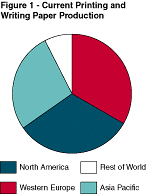
Western Europe and North America produce similar volumes of printing and writing paper, but Europe is much more important as a producer of coated grades in comparison to North America. North America is a large importer of coated paper grades, with net imports to the region amounting to 400,000-500,000 tons.
Europe is a net exporter of coated grades, but this was not always the case. In the early 1970s, coated grades accounted for 33% of total production in Europe and 31% of production in North America. The share of coated paper grades increased dramatically in Europe to reach some 50% of total output. Coated paper production in North America increased as well, but at a much slower pace and today it accounts for just 33% of the total printing and writing paper output (Figures 2 and 3). This disparity is obviously reflected in the different growth patterns seen since for mineral consumption in the two regions.

The balance between the alternative filler options has changed significantly over the years
Historical view
The combined consumption of the five major pigments for western Europe and North America was an estimated 6 million tons in the early 1970s. At present though, this has grown to some 15 million tons. This represents an annual growth rate of 6%, which compares to growth of 7% on an annual basis for the combined production in both regions of printing and writing paper.
Clearly though, growth patterns were quite different in western Europe than they were in North America. Coating pigment consumption grew at an annual rate of 8% in Europe, versus only 5% in North America. But filler pigment use showed lower growth in Europe at 4%, as opposed to North America where consumption of filler pigments grew at an annual rate of 7%.
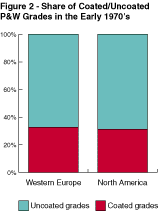 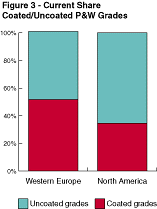
The reason for the difference is clearly illustrated when comparing the mineral mix in the early 1970s to the typical compositions seen currently. In North America in the early 1970s, coating pigments accounted for 62% of the total mineral consumption in the paper industry. Today, this has fallen to around 55%. In Europe in the early 1970s, coating pigments accounted for around 50% of the mix, but this percentage has grown, reaching slightly over 60% today.
One of the main reasons for this difference in the growth patterns over the years is the proportionately higher level of coated paper production in Europe. But a second reason for the difference is the increase in filling rate typical across North America. Traditionally, papers in Europe were much more highly filled than in North America. This is illustrated by the fact that in the early 1970s in both regions, coated paper accounted for some 31-33% of the total printing and writing paper production. At the same time, filler pigments accounted for nearly 50% of the mix in Europe, compared to less than 40% in North America in the early 1970s (Figures 4 and 5).
The growth of the coating segment in Europe is clearly mirrored by an increase in the share of coating pigment consumption. Conversely, the slight increase in the share of coated paper in North America is not reflected at all by any increase in the share of coating pigments. Rather, there has been a significant increase in the filler segment.
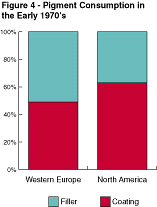 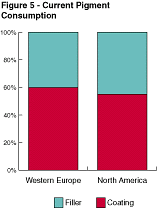
Winners and losers
In both regions, there has also been a major shift in the typical mineral composition used by the paper industry. Calcium carbonate has obtained a very large share of the pigment consumption, primarily at the cost of kaolin. For example, GCC accounted for only 3% of the European paper industry's mineral consumption in the early 1970s, but this has risen to around 45%. During the same period, the kaolin share has fallen from well over 80% in the early 1970s to around 40%. Consumption of precipitated calcium carbonate first fell from 4% in the early 1970s to just 1% in late 1980s. But this was followed by a remarkable increase to reach over 5% at present. Meanwhile, the share of talc has remained fairly constant during this whole period.
The situation is somewhat different in North America, where most of the growth was in precipitated calcium carbonate. PCC accounted for only 5% in the early 1970s and remained at roughly the same level until the late 1980s. But between 1988 and 1998, the pigment saw spectacular growth to reach over 25% of the total mineral consumption.
Again, most of the growth was at the cost of kaolin. Kaolin accounted for over 90% of the consumption in the early 1970s, but it has fallen to less than 60% today. Although less dramatic than PCC, ground calcium carbonate has also gained in importance, growing from 1% in the early 1970s to over 10% at present. Talc is of much less importance in the North American paper industry and is primarily used as a pitch control agent (Figures 6 and 7).
Changing the mix
An analysis of the use of coating pigments shows that calcium carbonate is much more widely used in Europe than in North America. In the early 1970s, kaolin accounted for well over 90% of the coating minerals used in West Europe, but kaolin's share in the paper industry is now below 50% of the total coating mineral consumption.
Precipitated calcium carbonate was used in very small amounts in the early 1970s and almost exclusively for certain specialty applications. The volume decreased during the 1970s and practically no PCC was used in coating until the mid to late-1990s. Recently though, a number of paper mills have restarted using PCC in trials for coating formulations.
Ground calcium carbonate was also used in very small amounts in the early 1970s, but even then it was beginning to increase its market share. At first, it was PCC that lost out, but later the proportion of GCC increased at the expense of kaolin. By the late 1990s, ground calcium carbonate had overtaken kaolin as the most popular coating mineral.
It is only comparatively recently that talc started being used as a coating pigment by the European paper industry. Talc was hardly used at all until the mid-1990s, but recently it has grown to make up about 5% of the coating pigments used in western Europe. Talc has gained a very strong position in rotogravure paper, again at the cost of kaolin.
In North America, developments in coating formulations have been somewhat slower to change and kaolin still accounts for the largest share of the coating market. In the early 1970s, kaolin accounted for 95% of all the coating minerals used in the region, but this has fallen slightly to under 80%. Ground calcium carbonate was not used in the early 1970s and is now estimated to have reached more than 20%.
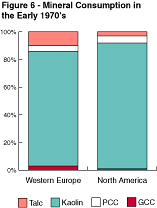 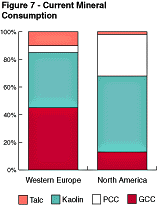
Filling up
Calcium carbonate accounts for more than 50% of filler pigment consumption in both western Europe and North America. But the PCC satellite concept is much more developed in North America than it is in Europe. In western Europe, kaolin accounted for over 80% of the consumption of filler pigments in the early 1970s, with the balance made up mainly by talc and calcium carbonate to a lesser extent. Kaolin's share has gradually fallen to about 40% of the total filler consumption.
During the 1970s and 1980s, ground calcium carbonate gained widely in importance. Currently, the volume of ground calcium carbonate used as a filler is nearly equal to the volume of kaolin being consumed as a filler in the paper industry.
The switch from acid to neutral papermaking has had a very dramatic effect on filler consumption. A neutral sizing process causes less damage to the cellulose fibers, therefore higher filler levels can be obtained in a neutrally sized paper compared to an acid sized paper. Typically, calcium carbonate slurries also have a higher solids content than kaolin slurries. This makes the slurry easier to apply and reduces the amount of water that needs to be driven off in the drying process, resulting in additional cost savings to the paper mill.
Another factor in the equation is that calcium carbonate also has a higher brightness than kaolin. Particularly in the past few years, there has been an increased drive towards brighter paper, which has generated a switch from chalk grades toward calcite and marble, as well as fuelling the consumption of PCC.
In the early 1970s, PCC was only used as a filler in the production of some specialty papers. Initially, natural ground calcium carbonate replaced PCC in some formulations, but following the success of on-site PCC production in North America, PCC gained further popularity and became the third most important filler pigment after kaolin and GCC.
In North America, kaolin accounted for over 90% of the filler consumption in the early 1970s, but that share has now dropped to around 35% of the total. Nearly all the growth went to PCC, which rose rapidly from being a minor specialized filler in the 1970s. The pigment grew fastest after the development of the satellite concept in the late 1980s to early 1990s.
In future, Kline expects that coating grades will continue to show a higher growth rate against filler grades and that calcium carbonate will continue to show higher growth than kaolin. Overall though, growth levels will be lower than suppliers have been used to in the past.
Consolidating base
In the early 1970s, most companies were active in just one region. Now, all the leading suppliers have a global presence. Even in the early 1970s in Europe, the supply of minerals was quite concentrated. The leading suppliers of talc, natural ground calcium carbonate, kaolin and PCC controlled over 40% of the supply in each of the mineral groups. Consolidation has increased in natural ground calcium carbonate and talc, but new suppliers have emerged for kaolin and PCC and they have slowly increased their market share.
The situation was quite different in North America. In the early 1970s, mineral supplies were far less concentrated with two or three leading suppliers in each of the major market segments. Consolidation strongly increased in PCC, but the supply situation still remains fairly fragmented in kaolin and GCC.
In Europe, English China Clays was the leading kaolin supplier in the early 1970s and still leads the sector. But a shift towards finer and higher brightness kaolin means that imported Brazilian and American clays have gained in importance quite considerably. In North America in the early 1970s, the top five suppliers accounted for about 70% of the total kaolin supply, with Engelhard and Huber each having around 20% of the market as the leading suppliers. The top five suppliers now account for over 85% of the market and the leading suppliers - English China Clays and Engelhard - still have market shares in the 20% range.
The ground calcium carbonate market is also much more consolidated. In the early 1970s, the Plüss Staufer-Omya group already had a strong position in the supply of GCC in Europe. The company aggressively increased its presence in the European market through the acquisition of a number of smaller producers, as well as by opening new mines and increasing capacities at its existing operations in Europe. Other major European suppliers include English China Clays and Faxe Kalk, but their market shares are significantly below that of Omya.
In the 1970s, the North American market for GCC was mainly for non-paper applications. The leading supplier at that time was Georgia Marble with a 30% market share, while the other leading suppliers all had market shares between 10% and 20%. In a market where paper grades have strongly increased their presence, Omya is now the leading supplier, closely followed by ECC, Georgia Marble (now DBK Minerals), Specialty Minerals and Huber.
The supply of PCC was largely determined by the success of the satellite concept. With no satellites operating in Europe, the market for PCC was strongly dominated by Solvay during the early 1970s, followed by a number of smaller regional suppliers. These companies are still key players in the merchant market. But two new suppliers - SMI and Faxe Kalk - emerged during the 1980s and because of the large output from their satellite plants, dominate current supply. Among recent developments in Europe was the acquisition of Faxe Kalk by Lhoist, which sold the company to Huber during 1998.
In North America in the early 1970s, there were four major merchant suppliers of PCC - Diamond Shamrock, BASF Wyandotte, Mississippi Lime and Pfizer. Diamond Shamrock and BASF Wyandotte ceased production in 1976, leaving only Pfizer and Mississippi Lime. Pfizer's PCC business was later spun off as Specialty Minerals (SMI) and embarked on an aggressive R&D, marketing and sales program to promote the satellite concept. The move helped the company establish itself as the leading PCC supplier in North America as well as on a global basis.
Future trends
Overall, Kline expects that the growth for calcium carbonate will continue to be higher than any increase in kaolin consumption. The group also expects that PCC will continue to demonstrate higher growth rates than GCC. There are some indications that talc could gain in importance for coating applications in North America.
The already high level of filler usage in Europe and the strong penetration of calcium carbonate (specifically for coating pigments) mean that growth rates in North America are likely to be higher than in Europe. Although new PCC satellite plants are being constructed in both North America and Europe, the expansion in volume terms is likely to be far more aggressive in North America.
This is despite the fact that the last woodfree paper mills in North America are now converting to alkaline paper production and on-site PCC production. As a result, limited opportunities remain for new conversions. But in volume terms, there will be significant growth from the impact of higher loading levels at existing paper mills. Coating pigment usage should also expand at a more rapid pace, but from a much lower starting point.
In Europe, most woodfree mills are already using GCC, while PCC satellite plants are primarily operating at a select number of woodfree paper mills. The startup of the first satellite unit at the Myllykoski SC (supercalendered) mill in Finland will certainly be viewed with interest by other papermakers. A number of mills are also starting to use PCC in coating formulations.
While TiO2 will continue to be used to improve brightness levels, it will face increased competition in applications where it is used for opacity such as LWC paper production. Likewise, calcined kaolin will still see some growth in newsprint and recycled paper applications.
The use of TiO2 and calcined clay has traditionally been far more restricted in Europe than North America. Nevertheless, calcined clay has been attracting more interest in Europe over the past few years and as long as calcined clay remains attractively priced, it will continue to grow in importance.
Coated paper producers in North America are taking a new look at talc as a coating pigment. This has come about partly as a response to the success of coating talc in Europe in rotogravure paper grades, but competition in North America from European rotogravure paper grades has also played a part. In Europe, most of the conversion to talc has already taken place and future growth will therefore be more modest.
Increased competition in the supply of coating kaolin will also be felt both in Europe and North America. This is mainly due to the increase in importance of Brazilian suppliers, as well as the ongoing overcapacity situation in the supply of calcined clay.
Although, the minerals supply business appears to be relatively concentrated compared to the customer base, further consolidation is likely. This was illustrated most recently in January 1999 by Imetal's bid to take over English China Clays. Imetal is the parent company of DBK Minerals.
Mark De Decker is a project manager at Kline Europe SA. He can be contacted by telephone at +32.2.770.47.40 or via e-mail at Kline.europe@pophost.eunet.be.
|